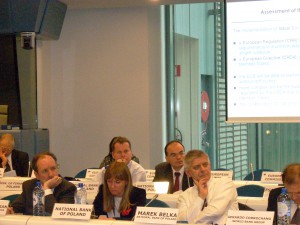About
Overview
The European Bank Coordination “Vienna” Initiative is a framework for safeguarding the financial stability of emerging Europe that was launched at the height of the global economic crisis in January 2009.
 Conceived as an emergency response to the threat of an exodus from emerging Europe by Western banks, it has now evolved to assume a permanent role in addressing dangers faced by the region’s financial sector.
Conceived as an emergency response to the threat of an exodus from emerging Europe by Western banks, it has now evolved to assume a permanent role in addressing dangers faced by the region’s financial sector.
A powerful example of a successful relationship between the public and private sectors, the Vienna Initiative brings together all the key stakeholders in the EU-based cross-border bank groups that are active in emerging Europe.
These include major international financial institutions as well as the most important European institutions, home and host country regulatory and fiscal authorities of large cross-border bank and the largest banking groups operating in emerging Europe.
The EBRD, EIB, European Commission, IMF, and the World Bank played a key role in the creation and further development of the Vienna Initiative.
Vienna 1.0
In its initial stage, the Initiative provided a forum for dialogue to create the right conditions for Western banks to remain engaged in emerging Europe.
The initial key objectives of the Initiative were the following:
- Prevent a large-scale and uncoordinated withdrawal of cross-border bank groups from the region, which could have triggered systemic bank crises not only in individual countries but in emerging Europe as a whole.
- Ensure that parent bank groups maintain their exposures and recapitalise their subsidiaries in emerging Europe
- Ensure that national support packages of cross-border bank groups benefited their subsidiaries in emerging Europe and thus avoided a “home bias”.
- Agree on, and implement, basic crisis management principles in the region
These objectives were achieved and the Initiative has been widely credited to have helped avoid a potentially region-wide systemic crisis in emerging Europe’s banking sector.
 Within the framework of the Vienna Initiative, the Joint IFI Action Plan also ensured that funding from the World Bank Group, the European Investment Bank Group and the EBRD was available to maintain a flow of credit to the real economies in the region.
Within the framework of the Vienna Initiative, the Joint IFI Action Plan also ensured that funding from the World Bank Group, the European Investment Bank Group and the EBRD was available to maintain a flow of credit to the real economies in the region.
Vienna Plus
Once systemic risks appeared to abate in late 2009, the Initiative moved to a new phase, called “Vienna Plus”. In this phase the Initiative used its unique public-private sector platform in order to analyse and advise on longer-term issues for future crisis prevention, such as the widespread lending in foreign currencies prevalent in the region. The framework was also kept alive in case of any aftershocks from the crisis.
As systemic risks started abating in the region from early 2010, the Initiative’s focus gradually shifted to critical region-wide policy issues that would make financial sectors in emerging Europe more resilient in the longer term, identified at the Initiative’s Full Forum meetings. Working Groups (WGs) comprising parent banks, regulators, central banks, ministries of finance, European institutions and IFIs, were then tasked to analyse:
- Basel III Implementation
- NPLs in Central, Eastern and Southeastern Europe
- Local Currency and Capital Market Development
- Role of Commercial Banks in the Absorption of EU Funds
Vienna 2.0
 But the eurozone sovereign debt crisis that erupted in the summer of 2011 presented new dangers to the region – and a new requirement on the Vienna Initiative to coordinate a response.
But the eurozone sovereign debt crisis that erupted in the summer of 2011 presented new dangers to the region – and a new requirement on the Vienna Initiative to coordinate a response.
“Vienna 2.0” was launched in January 2012, with the aim of avoiding disorderly deleveraging through coordinated action by home and host-country regulators and supervisors and the banks themselves.
A Steering Committee to coordinate the Vienna Initiative’s activities appointed Marek Belka, the President of the National Bank of Poland, as its first chairman in June 2012.
